Articles
- Page Path
- HOME > J Korean Acad Nurs > Volume 43(2); 2013 > Article
-
Original Article
- Development and Testing of a Nurse Turnover Intention Scale (NTIS)
- Eun Ja Yeun, Heejeong Kim
-
Journal of Korean Academy of Nursing 2013;43(2):256-266.
DOI: https://doi.org/10.4040/jkan.2013.43.2.256
Published online: April 30, 2013
1Department of Nursing, Konkuk University, Seoul, Korea.
2Department of Nursing, Namseoul University, Cheonan, Korea.
- Address reprint requests to: Kim, Heejeong. Department of Nursing, Namseoul University, 91 Daehak-ro, Seonghwan-up, Sebuk-gu, Cheonan-si, Chuncheongnam-do 331-707, Korea. Tel: +82-41-580-2715, Fax: +82-41-580-2931, yshbb@nsu.ac.kr
© 2013 Korean Society of Nursing Science
Abstract
-
Purpose
- The purpose of this study was to develop a measurement tool of nurse's turnover intention.
-
Methods
- Data were collected from questionnaires completed by 678 nurses who worked in 3 university hospitals in South Korea and analyzed using the SPSS 18.0 and AMOS 18 programs. Thirty-seven preliminary items were selected from 161 basic items extracted via a literature review and in depth interviews with 6 hospital nurses. Three steps with factor analysis were undertaken to verify the reliability and validity of the preliminary instruments. Finally, confirmative factor analysis was carried out.
-
Results
- As a result of the analysis, 3 factors including 10 items were selected. Cronbach's Alpha for the 10 items was .83, for job satisfaction (4 items), .78, for interpersonal relationships (3 items), .80, and for work performance (3 items), .74, which was stable.
-
Conclusion
- This study is meaningful because through it a scale reflecting Korean culture was developed to measure turnover intention in nurses. Further studies that test the psychometrics of this scale in more diverse samples are warranted.
- 1. Aiken LH, Clarke SP, Sloane DM, Sochalski J, Silber JH. Hospital nurse staffing and patient mortality, nurse burnout, and job dissatisfaction. JAMA. 2002;288(16):1987–1993.ArticlePubMed
- 2. Becker TE. Foci and bases of commitment: Are they distinctions worth making. Acad Manag J. 1992;35(1):232–244.Article
- 3. Cammann C, Fichman M, Jenkins D, Klesh JR. Seashore SE. The michigan organizational assessment questionnaire. In: Assessing organizational change: A guide to methods, measures, and practices. 1983;New York, NY, Wiley. 71–138.
- 4. Cho CH, Kim MS. An effect of nurses' job stress and job burnout, job satisfaction and turnover intention: Focusing on large-sized hospital in Daegu Gyeongbuk area. 2010;11;Paper presented at the Korean Academic Association of Business Administration, Seoul.
- 5. Choi SH. Eight out of ten workers suffers 'workplace hwa-byung'. MoneyToday. 2008;Retrieved October, 13, 2008. from http://news.mt.co.kr/mtview.php?no=2008101308280673003&type=&VR.
- 6. Choi YH. A study on stress and job satisfaction among oriental hospital nurses. J Korean Acad Nurs Adm. 1999;5(1):169–180.
- 7. Cook JD, Hepworth SJ, Wall TD, Warr PB. The experience of work: A compendium and review of 249 measures and their use. 1981;New York, NY, Academic Press.
- 8. Cooper CL, Marshall J. Occupational sources of stress: A review of the literature relating to coronary heart disease and mental ill health. J Occup Psychol. 1976;49(1):11–28. http://dx.doi.org/10.1111/j.2044-8325.1976.tb00325.x.Article
- 9. Flinkman M, Laine M, Leino-Kilpi H, Hasselhorn HM, Salanterä S. Explaining young registered finnish nurses' intention to leave the profession: A questionnaire survey. Int J Nurs Stud. 2008;45(5):727–739. http://dx.doi.org/10.1016/j.ijnurstu.2006.12.006.ArticlePubMed
- 10. Hospital Nurses Association. Research on the status of nursing personnel. 2011;Seoul, Author.
- 11. Jones CB. Calculating and updating nursing turnover costs. Nurs Econ. 1992;10(1):39–45. 78. PubMed
- 12. Kang BS, Kim KS. SPSS 17.0: Statistical analysis of the social sciences. 2009;Seoul, Hannarae Academy.
- 13. Kim IS. The role of self-efficacy and social support in the relationship between emotional labor and burn out, turn over intention among hospital nurses. J Korean Acad Nurs Adm. 2009;15(4):515–526.
- 14. Kim YH, Choi JH, Kim KE. The impact of job overload, relationship with senior on nurses' intention to quit their jobs -Mediating role of emotional exhaust-. J Korean Acad Nurs Adm. 2009;15(3):372–381.
- 15. Koo OH. Clinical nurses's perception of empowerment structural model in nursing organization. 2000;Daejon, Chungnam National University. Unpublished doctoral dissertation.
- 16. Kwon DW, Ko HJ. A study of job stress and turnover intension related to transfer of duty post of staff nurses in the general hospitals. J Korean Acad Nurs Adm. 2003;9(1):141–150.
- 17. Lawler EE. Satisfaction and behavior. 1983;New York, NY, McGraw-Hill.
- 18. Liou SR. Nurses' intention to leave: Critically analyse the theory of reasoned action and organizational commitment model. J Nurs Manag. 2009;17(1):92–99. http://dx.doi.org/10.1111/j.1365-2834.2008.00873.x.ArticlePubMed
- 19. Lynn MR. Determination and quantification of content validity. Nurs Res. 1986;35(6):382–385.PubMed
- 20. Min S, Kim HS, Ha YJ, Kim EA, Kim HY, Kim HJ, et al. The controlling effect of the self-efficacy in the job stress of hospital nurse on job satisfaction. Korean J Bus Adm. 2011;24(1):1–21.
- 21. Ministry of Health & Welfare. Ministry of health and welfare year book 2010. 2010;12;Retrieved January, 2011. from http://stat.mw.go.kr/front/statData/mohwAnnalsWpView.jsp?menuId=14&bbsSeq=1&nttSeq=16495&nttClsCd=01&searchKey=&searchWord=&nPage=1.
- 22. Mobley WH. Employee turnover: Causes, consequences, and control. 1982;Reading. MA, Addison-Wesley Publishing Co.
- 23. Park HS. Relationship between perceived nursing care role orientation, job characteristics, and turnover among nurses. 2002;Seoul, Yonsei University. Unpublished master's thesis.
- 24. Porter LW, Smith FJ. The etiology of organizational commitment. 1970;Irvine, CA, USA, University of California at Irvine. Unpublished paper.
- 25. Seashore SE, Lawler EE, Mirvis P, Cammann C. Observing and measuring organizational change: A guide to field practice. 1982;New York, NY, Wiley.
- 26. Seo YY, Ju HO. Influence of nursing organizational culture on empowerment as perceived by new nurses. J Korean Acad Nurs Adm. 2011;17(1):88–95.Article
- 27. Shader K, Broome ME, Broome CD, West ME, Nash M. Factors influencing satisfaction and anticipated turnover for nurses in an academic medical center. J Nurs Adm. 2001;31(4):210–216.ArticlePubMed
- 28. Sung YH, Hwang MS, Kim KS, Chun NM. Influence of clinical nurse specialists' emotional intelligence on their organizational commitment aand turnover intention. J Korean Acad Nurs Adm. 2010;16(3):259–266.Article
- 29. Tulgan B. Generation X-The workforce of the future. 2000;Retrieved October, 9, 2000. from http://www.rainmakerthinking.com/.
- 30. Yoon GS, Kim SY. Influences of job stress and burnout on turnover intention of nurses. J Korean Acad Nurs Adm. 2010;16(4):507–516.Article
REFERENCES
Figure & Data
REFERENCES
Citations

- Prevalence and Moderating Factors of Turnover Rate and Turnover Intention Among Nurses Worldwide: A Meta-Analysis
Dluha Mafula, Hidayat Arifin, Ruey Chen, Chien-Mei Sung, Chiu-Kuei Lee, Kai-Jo Chiang, Kondwani Joseph Banda, Kuei-Ru Chou
Journal of Nursing Regulation.2025; 15(4): 20. CrossRef - Turnover intention, collaboration and competences of intensive care unit nurses: A descriptive correlational study
Miyase Avcı, Ahmet Avcı
Applied Nursing Research.2025; 82: 151930. CrossRef - Impact of Professional Quality of Life on Turnover Intention among General Hospital Nurses: A Comparative Study Using Linear and Nonlinear Analysis Methods
Mi-Jin Park, Il-Ok Kim
Journal of Korean Academy of Nursing Administration.2025; 31(1): 132. CrossRef - The effect of nurses’ individual and occupational characteristics and perceptions of hierarchical career plateau on their turnover intention: A cross-sectional study
Şehrinaz Polat, Tuğba Yeşilyurt Sevim, Hanife Tiryaki Şen, Roaa Sabri Gassas
PLOS ONE.2025; 20(4): e0316895. CrossRef - The effects of communication competence, meaning of work, and work-life balance on turnover intention in Generation Z nurses in South Korea: A cross-sectional study
Kyu-Yeon Jeong, MiRa Yun, Eun-Hi Choi
Applied Nursing Research.2025; 83: 151952. CrossRef - Investigation of the relationship between work motivation, work performance and turnover intention of surgical nurses: a cross-sectional study
Nihal Celikturk Doruker, Gulver Hacioglu, Birgul Nurulke, Leyla Ceylan
Applied Nursing Research.2025; 83: 151960. CrossRef - Influence of COVID-19–Induced Anxiety on Job Turnover Intention among Emergency Room Nurses during the COVID-19 Pandemic, the Mediating Effect of Needs Satisfaction: A Cross-Sectional Study
YuJin Seo, Myung Kyung Lee
Korean Journal of Adult Nursing.2025; 37(2): 104. CrossRef - Relationships Between Nurses' Personal and Professional Characteristics and Career Decision Regret, Occupational Stress and Turnover Intention: A Descriptive Cross‐Sectional Study
Şehrinaz Polat, Aslı Yeşil
International Journal of Nursing Practice.2025;[Epub] CrossRef - Job Satisfaction, Quality of Life, and Turnover Intention Among Nurses: A Comparative Study of Pattern-Based and Rotating Shift Schedules
Yu Jin Jung, Haejin Kim
Healthcare.2025; 13(20): 2551. CrossRef - Psychometric evaluation of the Chinese version of the nurse turnover intention scale: a translation and validation study
Wenguang Xie, Xinyue Zhao, Xiaoyu Liu, Xinchen Yang, Yulu Deng, Yangyang Zhang, Chao Zhang, Yanyan Gong
BMC Nursing.2024;[Epub] CrossRef - Effects of Resilience, Nursing Managers’ Empowering Leadership on Turnover Intention among New Nurses: Mediating role of Transition Shock
Hyun Jin Jung, Hyun Kyung Kim, Seok Hee Jeong
Journal of Korean Academy of Nursing Administration.2024; 30(3): 212. CrossRef - Impact of Emotional Labor and Positive Psychological Capital on the Turnover Intention of Nurses Caring for Patients with COVID-19: A Descriptive Survey Study
Mira Kwon, Yeoungsuk Song, Majd T. Mrayyan
Journal of Nursing Management.2024; 2024: 1. CrossRef - Effect of Work-Family Conflict on Turnover Intention among Married Female Nurses: The Mediating Effect of Nursing Work Environment
Min Gyeong Jeong, So Young Choi
Journal of Korean Academy of Nursing Administration.2024; 30(5): 451. CrossRef - The mediating and moderating role of recovery experience between occupational stress and turnover intention in nurses caring for patients with COVID‐19
Junghoon Lee, Junekyu Kim, Hong‐A Lim, Yeoungsuk Song
Journal of Clinical Nursing.2024; 33(4): 1470. CrossRef - Effects of Job Crafting, Burnout, and Job Satisfaction on Nurses' Turnover Intention: A Path Analysis
Mihee Chung, Sujeong Han
Journal of Korean Academy of Fundamentals of Nursing.2023; 30(2): 281. CrossRef - The Effect of Missed Nursing Care on Adverse Event Experiences, Patient Safety Management Activity, Job Satisfaction and Turnover Intention in Nurses: A Nationwide Survey using Proportional Quota Sampling
Myung Jin Choi, Seok Hee Jeong
Journal of Korean Academy of Nursing Administration.2023; 29(4): 490. CrossRef - The adaptation of the Nurse Turnover Intention Scale into Turkish: A validity and reliability study
Arife Şanlıalp Zeyrek, Özlem Fidan, Nesrin Çunkuş Köktaş
International Journal of Nursing Practice.2023;[Epub] CrossRef - Mediating Effect of Job Satisfaction on the Relationship between Nursing Practice Environment and Turnover Intention of Nurses in a National Forensic Psychiatic Hospital
Moonhee Gang, Donghyeon Gwak
Journal of Korean Academy of psychiatric and Mental Health Nursing.2023; 32(3): 307. CrossRef - Impact of workplace bullying and resilience on new nurses' turnover intention in tertiary hospitals
Gyu Li Baek, EunJu Lee
Nursing & Health Sciences.2022; 24(4): 801. CrossRef - The Factors That Affect Turnover Intention According to Clinical Experience: A Focus on Organizational Justice and Nursing Core Competency
Hanna Choi, Sujin Shin
International Journal of Environmental Research and Public Health.2022; 19(6): 3515. CrossRef - Modeling the mediation roles in the relationship between job satisfaction and organizational commitment of public sector forest engineers in Turkey
Yaşar Selman Gültekin
Journal of Forest Research.2022; 27(4): 255. CrossRef - Effects of Ego-Resiliency on Interpersonal Problems among Nursing Students: The Mediating Effects of Aggression
Sona Lee, Hye Young Ahn, Hye Seon Choi
Healthcare.2022; 10(12): 2455. CrossRef - A meta‐analysis on predictors of turnover intention of hospital nurses in South Korea (2000–2020)
Hyeoneui Kim, Eun Gyung Kim
Nursing Open.2021; 8(5): 2406. CrossRef - Emotional Labor, Burnout, Medical Error, and Turnover Intention among South Korean Nursing Staff in a University Hospital Setting
Chan-Young Kwon, Boram Lee, O-Jin Kwon, Myo-Sung Kim, Kyo-Lin Sim, Yung-Hyun Choi
International Journal of Environmental Research and Public Health.2021; 18(19): 10111. CrossRef - Effect of Verbal Violence on the Turnover Intention among Operating Room Nurses: Focusing on the Moderating Effects of Social Support and Coping
Ae-Sook Kim, Eun Hee Jang
Journal of Korean Academy of Nursing Administration.2021; 27(5): 433. CrossRef - Effects of Workplace Bullying and Empowerment on Nurses' Turnover Intention
Yesul Lee, Yoonju Lee, Ju-Young Ha, Minjeong Jo
Journal of Korean Academy of Nursing Administration.2021; 27(1): 1. CrossRef - Factors associated with the nurses’ intent to stay in China, Japan, and Korea: an integrative review
Ting Xue, Wen-Bin Jiang, Meng-Di Ma, Jie Zhang, Ming-Hui Lu, Yong-Mei Jiang
Frontiers of Nursing.2020; 7(3): 269. CrossRef - Impact of nurse staffing on intent to leave, job satisfaction, and occupational injuries in Korean hospitals: A cross‐sectional study
Sujin Shin, Seung Jin Oh, Jeonghyun Kim, Inyoung Lee, Sung‐Heui Bae
Nursing & Health Sciences.2020; 22(3): 658. CrossRef - Influence of Secondary Trauma Stress, and Vocation on Turnover Intention of Nurses in Regional Trauma Centers
Hyun-Gwan Lee, Ji-Soo Kim
Journal of Korean Academy of Nursing Administration.2020; 26(1): 65. CrossRef - Nursing stress factors affecting turnover intention among hospital nurses
Eun‐Kyoung Lee, Ji‐Soo Kim
International Journal of Nursing Practice.2020;[Epub] CrossRef - Relationship of Workplace Violence to Turnover Intention in Hospital Nurses: Resilience as a Mediator
Hyun-Jung Kang, Jaeyong Shin, Eun-Hyun Lee
Journal of Korean Academy of Nursing.2020; 50(5): 728. CrossRef - Relationship between Types of Role Conflict and Turnover Intention in Nurses Working at Rehabilitation Hospitals
Bo Young Kim, Joo yun Lee
The Korean Journal of Rehabilitation Nursing.2019; 22(2): 142. CrossRef - Trends in Turnover Research on Korean Nurses: Based on 8 Journals Published by Member Societies under the Korean Academy of Nursing Science, 2006-2015
Hyo Geun Geun
The Open Nursing Journal.2019; 13(1): 92. CrossRef - Influence of Communication Competency and Nursing Work Environment on Job Satisfaction in Hospital Nurses
Bongjeong Kim, Soon Young Lee, Gyeong Ju An, Guna Lee, Hyun Jung Yun
Journal of Health Informatics and Statistics.2019; 44(2): 189. CrossRef - Effects of Emotional Development Therapy (EDT) on Stress, Fatigue, Sleep, and Heart Rate Variability (HRV) in Nurses
Mi-Young Jeong, Nam-Sook Seo
Korean Journal of Stress Research.2018; 26(1): 60. CrossRef - Pediatric Nurses’ Perceptions related to End-of-Life Care and Turnover Intention
Sook Young Baek, Sook Jung Kang
Child Health Nursing Research.2018; 24(4): 353. CrossRef - Influences of Interpersonal Problems and Character of Nurses on Quality of Nursing Service
Eun-Yi Yeom, Kawoun Seo
Journal of Korean Academy of Nursing Administration.2018; 24(5): 445. CrossRef - Relationship of Gender Role Conflict and Job Satisfaction to Turnover Intention for Men in Nursing
Ha-Man Hwang, Myung Ja Kim
Journal of Korean Academy of Nursing Administration.2017; 23(1): 32. CrossRef - Analysis of Research Articles Published in the Journal of Korean Academy of Nursing Administration for 3 Years (2013~2015): The Application of Text Network Analysis
Tae Wha Lee, Kwang-Ok Park, GyeongAe Seomun, Miyoung Kim, Jee-In Hwang, Soyoung Yu, Seok Hee Jeong, Min Jung, Mikyung Moon
Journal of Korean Academy of Nursing Administration.2017; 23(1): 101. CrossRef - Factors Affecting on Turnover Intentions among Operating Room Nurses
Yeo-Jin Kim, Keum-Sook Park, Eun-Ja Yang
Journal of the Korea Academia-Industrial cooperation Society.2016; 17(12): 352. CrossRef - Factors Influencing Hospital Nurses' Turnover Intention: A Cross-sectional Survey
Eun-Ja Yeun, Young-Mi Kwon, Mi-Soon Je, Jeong-Hwa An
The Journal of the Korea Contents Association.2016; 16(1): 94. CrossRef - Interpersonal Relations, Hope, Professional Self-concept and Turnover Intention according to Adult Attachment Styles in Early Stage Nurses
Eun Jin Oh, Se Young Lee, Kyung Mi Sung
Journal of Korean Academy of Nursing Administration.2013; 19(4): 491. CrossRef
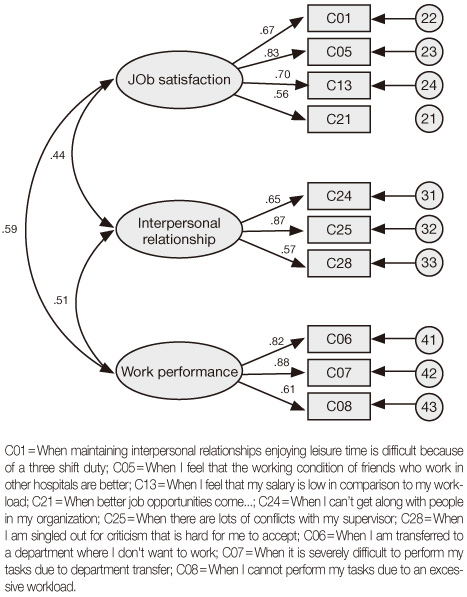
Figure 1
General Characteristics (N=678)
The Initial Factor Analysis (N=190)
KMO=Kaiser-Meyer-Olkin.
Step 1. Factor Analysis (N=190)
KMO=Kaiser-Meyer-Olkin.
Step 2. Factor Analysis (N=151)
KMO=Kaiser-Meyer-Olkin.
Effect of Each Path of Confirmatory Factor Analysis of Turnover Intention (N=147)
GFI=Goodness of fit index; CFI=Comparative fit index; NFI=Normal fit index; NNFI=Non-normed fit index; RMR=Root mean square residual; RMSEA=Root mean square error of approximation; KMO=Kaiser-Meyer-Olkin.
KMO=Kaiser-Meyer-Olkin.
KMO=Kaiser-Meyer-Olkin.
KMO=Kaiser-Meyer-Olkin.
GFI=Goodness of fit index; CFI=Comparative fit index; NFI=Normal fit index; NNFI=Non-normed fit index; RMR=Root mean square residual; RMSEA=Root mean square error of approximation; KMO=Kaiser-Meyer-Olkin.
 KSNS
KSNS
 E-SUBMISSION
E-SUBMISSION

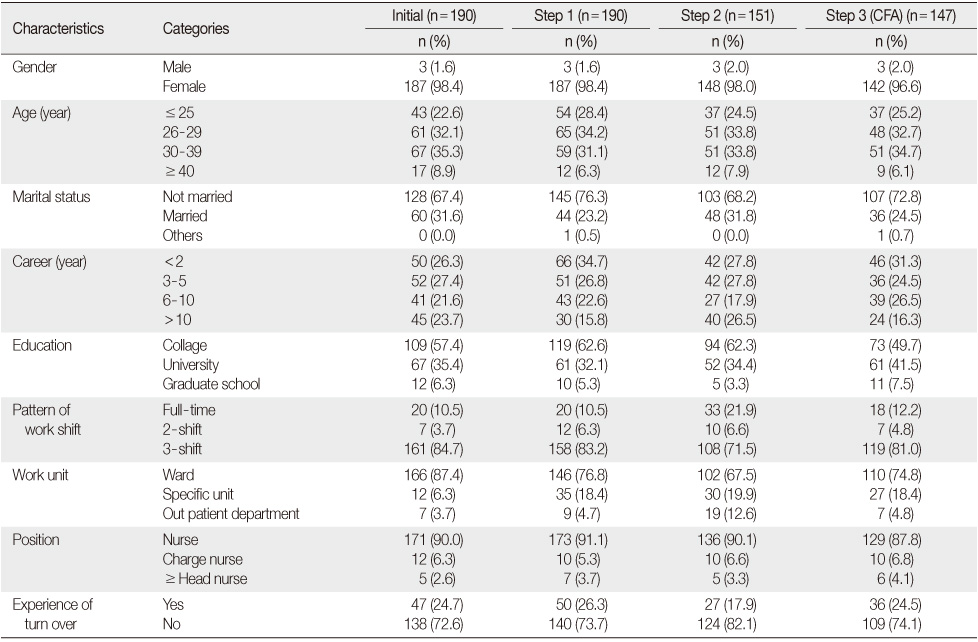
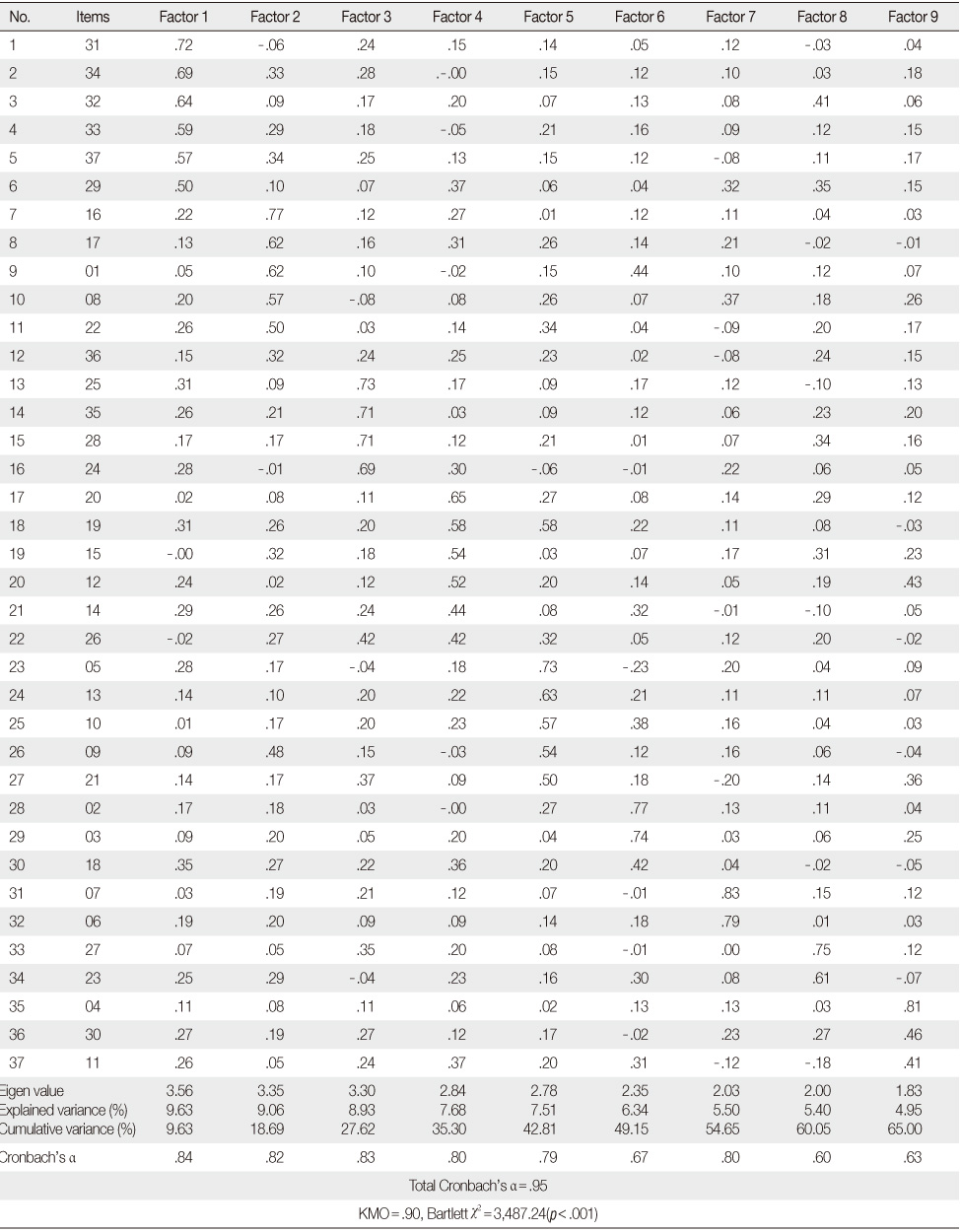
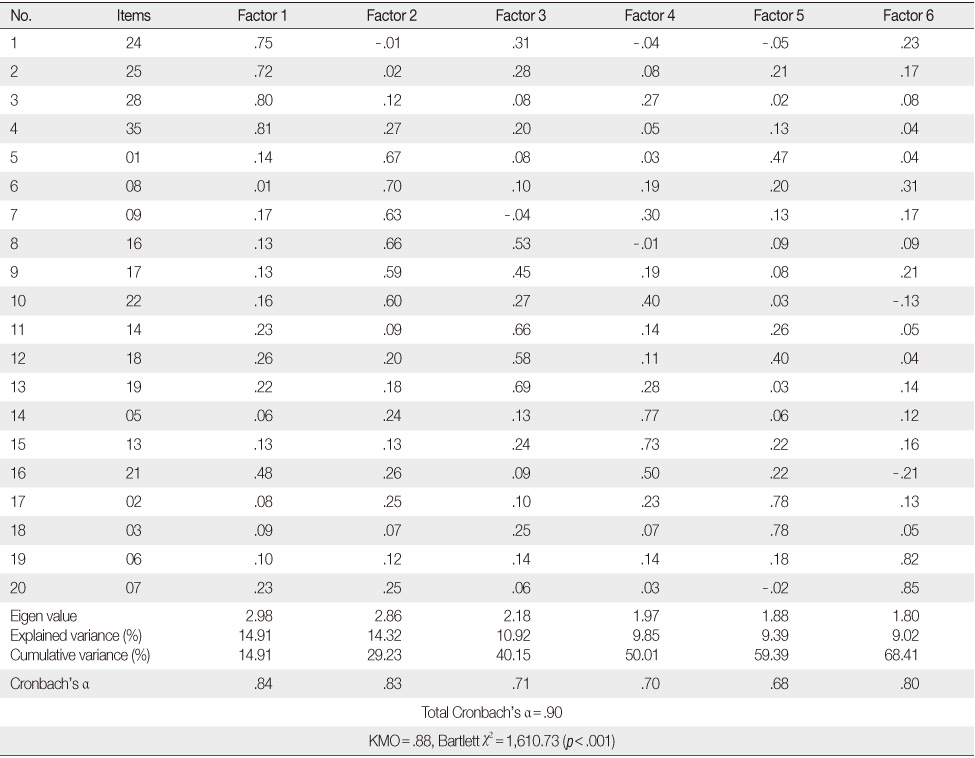
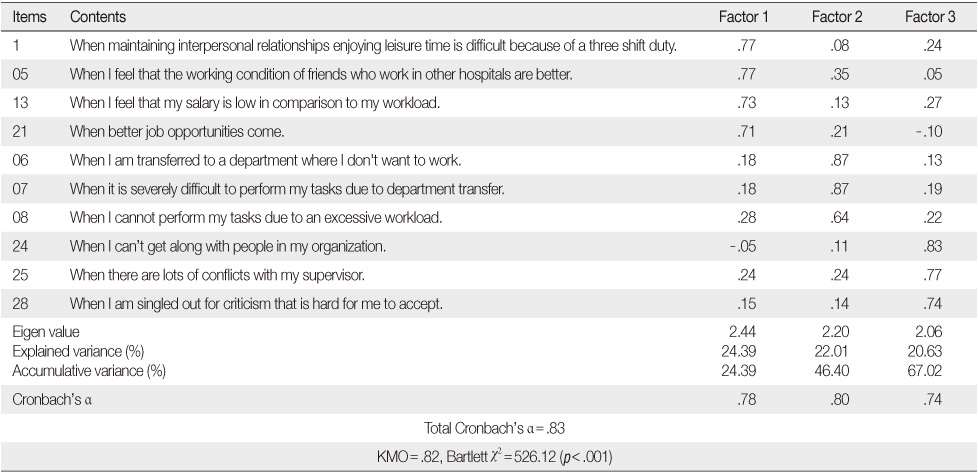

 Cite
Cite

